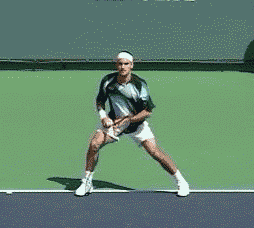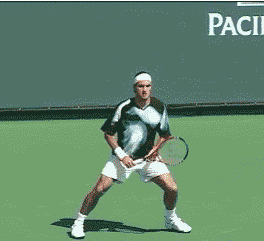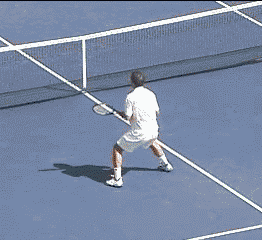|
TennisOne Lessons Emulating the Sampras/Federer Game John Officer, Head tennis coach US Naval Academy
It is common knowledge that Pete Sampras molded his game after Rod Laver. He switched from a two-handed backhand mid-way through his junior career and proceeded to win 14 major championships. And it must be said that this proved to be a difficult transition. For the first few years Pete had many a loss to those juniors who pounded his new “or under construction” one-handed backhand. Sampras' game is the perfect style for players over six feet tall with solid athletic abilities. I am truly amazed that we don't have more junior players in this country emulating his style. Having spent the past twenty plus years at our U.S. Junior Nationals, I can count on one hand the number of players who are truly trying to play this game. This Rod Laver/Pete Sampras/Roger Federer game may be extremely difficult to master but it is better suited for the pro game for certain players, and equally, it is better suited for anyone really working on the big picture. This game requires the player to learn slice and topspin off the backhand, serve and volley, chip and topspin backhand returns, the ability to come in off drive and chip returns, floating in after well placed groundstrokes, as well as developing all of the basic shots. The game requires hours of practice to perfect the combinations of strokes used to construct various types of points. But when mastered, this game can take apart more limited players with fewer options. And certainly that has been true when Laver or Sampras, and now Federer dominate seemingly competitive opponents.
Roger Federer has now taken the Laver/Sampras game to a new level. He can hit every shot in the book technically correctly. His sense of flow as he switches from one stroke to the next is magical to watch. Typically, in the progression of this type of game there are setbacks. Often players struggle with hitting a quality ball and at the same time using various strokes in varying situations. There are more decisions to make (or to make incorrectly) when the choices are a chip, a biting slice, a drive, a topspin drive, or a dipping topspin drive, and certainly it does take longer to learn such a game. It takes time to develop a biting slice backhand, and the ability to chip and charge to mention just a few of the strokes. The game, at its highest level, enables players to play with a complete sense of flow and with ease on all parts of the court. Roger Federer is a perfect example of that. The teaching pros are often guilty when not transitioning their players to a more sophisticated game. Too often U.S. juniors have very simple linear games with little creativity. The object is to hit through their opponent off the ground. Angles, off pace, and heavier balls are seldom implemented. There is anxiousness with our players when they play points, not found in many foreign players who grow up on clay. This may be the result of the lack of credible options in their games.
The limited repertoire has players playing more on rote memory and less from the heart. Players who can play from the heart are much more creative. The heart can be described as the quiet voice inside yourself which taps into our natural instincts. The mind on the other hand simply regurgitates logical information. Creativity and freedom about the court are part of truly what makes this a game rather than a grind – which is somehow what the grinders turn it in to. Here are pictures of this style from a technical perspective. The forehand must be struck with a compact loop backswing, an open stance, hit generally off the ground, and with good leg drive off the back knee. The inside out forehand should be a weapon, hitting it both to the backhand or forehand court. The backhand needs excellent shoulder turn, use of the left hand as a guide, back knee drive, and a smooth stroke. The left hand palm is flattened out and kept level with the back shoulder. Too often we see players swing their left hand slightly forward which throws off the balance of the shot. The slice is a key to this all court game. It is important to start the racquet slightly above the ball, finish with the left hand behind at the same height as the right (“wings”), press firmly forward with the butt of the racquet, stay sideways, and finish high. Laver, Sampras, and Federer all had excellent slice backhands. The slice enables the player to take the pace off the ball, and to neutralize an opponent. It makes other plays and strokes better including the chip and charge, chip return and in, drop shot, chip return, dink passing shot, and the backhand volley. Each of these shots will be enhanced by the slice backhand.
The backhand topspin return requires good back knee drive, a compact stroke, a strong wrist, and a simple low to high stroke. The backhand chip return is an extended version of the backhand volley with an added follow through. The backhand approach should be hit with both under spin and topspin. Both require planting the front foot and then using a hopping motion to proceed forward. Interestingly building the underspin backhand groundstroke will pay immediate dividends for the student's backhand volley. The forehand approach should be taken off the inside foot and then extending off the ground with the feet. Approaches require a more abbreviated backswing. Passion shots also require a brief backswing and the ability to dip the ball at the feet of the net man. The volleys require very good back knee drive, a sense of forward flow, with the momentum bring your feet off the ground on the follow through. It is important to slice the volley in order to make the ball skid. Drop volleys and angle volleys are much easier when using under spin. Often you will see the U.S. juniors hitting flat volleys that break down and do not neutralize your opponent.
The overhead should be hit with a scissor kick almost exclusively which requires good athletic ability. But note how many juniors, even Roddick and Agassi as well, who will bounce the lob and play a “tweener” or even a high forehand – why is it that Laver or Sampras or Federer never hit the tweener (match point against Safin the notable exception here)? Simple, they always, repeat always, took or take the overhead in the air unless the lob has been absolutely perfect. Rod Laver, Pete Sampras, and Roger Federer each owned all these shots. In match play you need different tools to beat various opponents. Federer and Sampras have shown us that they are as comfortable serving and volleying on both serves as they are in a long backcourt rally. Federer at the U.S. Open beat Agassi with very few net approaches, and on the other hand, won Wimbledon with a much more attacking style. Flexibility gives the player the ability to switch gears in the middle of the match if they sense another tactic would be better. This type of game requires teaching professionals and their students to think much more in the long term. The all court game takes time to be perfected. If you have a player over six feet tall and has good athletic skills, this time tested style can work. It is best if the change is done in the 16 and unders to allow enough time for sufficient progress. Note: Something remarkably similar was written by Trey Waltke in the 1980's and the following excerpt hauntingly presages this article. “Having recently returned from the Easter Bowl Junior Tennis tournament, I couldn't help comparing this group of juniors to my group of 15 years ago. True, these comparisons are what all older players do, but nevertheless, I couldn't help myself.
As a group, the kids coming up today have harder forehands and harder backhands. Their ability to hit outright winners from the baseline is amazing. Everyone seems to have a great two-handed backhand or a huge topspin forehand. These kids can go corner to corner forever. There is an area on the court, which kids today seem to view as the forbidden zone, but I like to think of as the forgotten zone. I'm referring to the middle of the court, or the midcourt, the area about three feet behind and in front of the service line. What I'm merely suggesting is that kids stop all this drilling and start playing more meaningless sets where they can risk “foolin' around” in the midcourt. They must learn to feel at home in this area. The advantages of using the midcourt are incredible. To name a few: It shortens points and saves energy. Your opponent will always be trying to second-guess your whereabouts on the court. But most importantly – it relieves boredom and burnout later in your tennis career by encouraging creativity during play.” Your comments are welcome. Let us know what you think about John Officer's article by emailing us here at TennisONE. |






 Classic Sampras overhead.
Classic Sampras overhead.